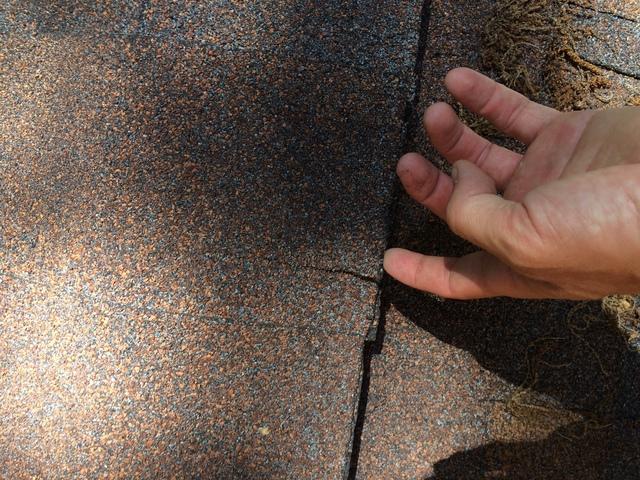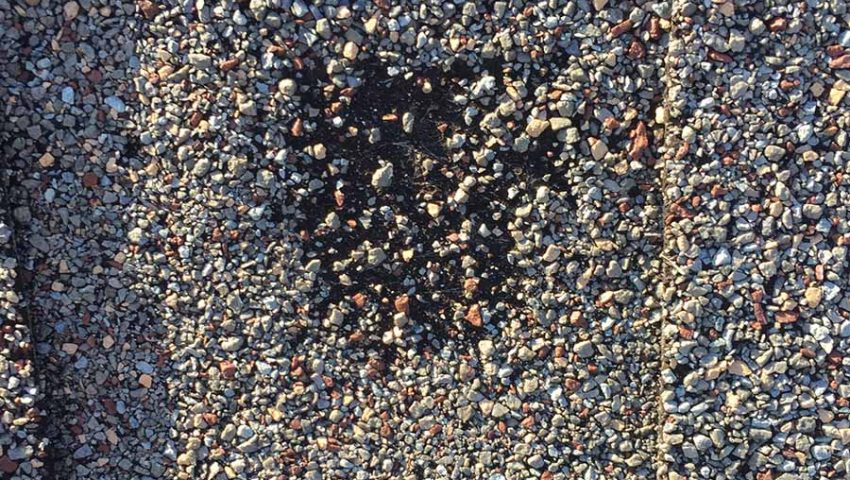Colorado weather can be unpredictable, and when strong storms sweep through the Front Range, you can expect hail to be part of the storm. Hail damage on roofs can happen from any hail storm, even the brief storms that quickly pass through. Calling a Denver roofing contractor is the first step to get a hail damage roof inspection on your home or business.
Most homeowners are not experts in evaluating roof hail damage. However, it’s good for homeowners to know some basic information about hail damage to roofs. Here are some of the most common types of hail damage on roofs.
1. Loss of asphalt granules where hail hit the shingle. An asphalt shingle is covered with small mineral granules that allow water to flow down and away from the roof, and the granules protect the asphalt coating, which is how the roof is protected from water seepage. When hail hits the shingle, it causes an indentation that removes some of the granules. If the granules are missing, the asphalt coating becomes exposed to the elements, and this means your roof has lost some of its waterproofing. Missing granules are not just a cosmetic problem. Some roofing Denver contractors will offer a sugaring treatment instead of a roof replacement. Sugaring is a temporary fix where granules are applied to the shingles using asphalt cement. A qualified company that does roofing in Denver will not offer this treatment because it is not a permanent solution to hail damage on roof.
2. Visible cracks in the granules on the surface of the asphalt shingle. It’s typical for granules to be displaced in a divot pattern since hailstones are round. However, the granules on the surface of the asphalt shingle may show a cracked pattern that radiate out from the point of impact. It is more common to see cracks if the hail storm also included a wind storm. High winds can bend the shingles back, and this is what causes the shingle to appear cracked.
3. Unprotected asphalt coating. An asphalt shingle is protected with an asphalt coating or fiberglass mat on the layer below the granules. After the granules have been knocked off from hail damage, the asphalt coating or fiberglass mat is exposed to the elements.
4. Cracked asphalt coating. The asphalt coating or fiberglass mat may be cracked, and it may not be visible right away. A fractured fiberglass mat can show a tear or crack that radiates out from the point of impact. However, if hail damage to the fiberglass mat is not immediately seen, the mat can become cracked or torn over time as the shingles get older.
5. Separation of the self-sealing strip. Asphalt shingles have a self-sealing strip that is applied to the roof surface during the roof installation process. Hail damage can cause this strip to separate from the shingle, and when the wind comes, the shingle can detach from the roof and blow away.

Is hail damage on roof immediately visible after a hail storm?
The answer is yes and no. The impact of roof hail damage may be immediately visible if the hail storm produced giant hailstones. However, smaller hail can still cause hail damage on roof that is not noticeable right away. It can take months or even years to see it. Hail damage to roofs can cause premature aging of the shingles. For this reason, it is very important to contact a Denver CO roofing company to conduct a hail damage roof inspection to look for roof hail damage.
What does roof hail damage look like?
Hail damage to roofs looks like divots, indentations and fractures on the surface of the shingle. Because hail falls in a random pattern, roof hail damage can also appear as a random pattern on the roof, flashings, and siding. When you see the asphalt granules clustering together, there’s a good chance the shingle is damaged.
Can shingles be removed and replaced, or do I need a roof replacement?
There are some instances where removing and replacing individual shingles with hail damage can be a temporary solution to maintain the roof’s performance. However, a roofing Denver Colorado expert must evaluate the hail damage on roof to determine if the surrounding shingles are also damaged. For example, if one shingle shows hail damage with a divot or crack, you know that shingle is damaged. But what about the shingles surrounding it? If those shingles don’t show any obvious damage and a qualified Denver roofing contractor does a hail damage roof inspection, the roofer may not be able to assess invisible damage. There is a high likelihood that if a few shingles show obvious hail damage, all the shingles could have unseen damage. For this reason, a complete roof replacement is often recommended by a Denver CO roofing company for long-term roof performance. If the hail damage is only visible on one plane of the roof, a roof replacement on just that section of the roof may be possible. If individual shingles are removed and replaced, any nails that were used on the surrounding shingles must be replaced, and the surrounding shingles must be resealed for optimal results.
Peak to Peak Roofing is a Denver CO roofing company. We offer roofing in Denver and the entire metro area. Contact usto get a free hail damage roof inspection. Our qualified Denver roofing contractors will provide expert advice about roof hail damage and roof replacement options.

